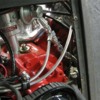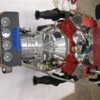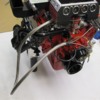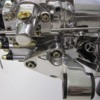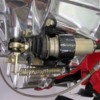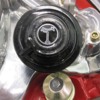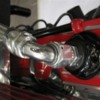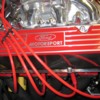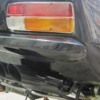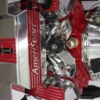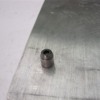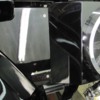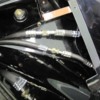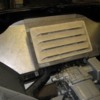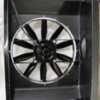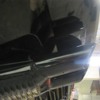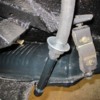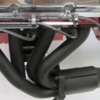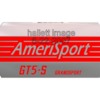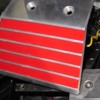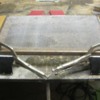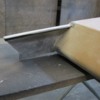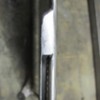Here is a better detail---you can see the water pump mount loop for the oil and fuel pressure lines. The fuel pressure is connected and the oil pressure feeds to a connection just above the oil filter.
The gauge cluster can be removed and located as far back as picture shows---rear of the trans axle. If you are working the engine, this gives you great info at your fingertips and a great back-up if the power fails to the main gauge console.
Attachments
This shows the new wire looms and changed the color to black. This shot also shows the inner air box with the vapor seal flapper valve vacuum control pod on top. At the back of the box, you can see the stainless fitting the a bit of the tube which feeds the break booster up front.
Attachments
Wayne has original paint on his car. I had to repair some door dings and of coarse the front spoiler was damaged---fortunately blending the paint from the damaged area into the original color was successful.
We sanded the entire car with 600, 1200, and 2000 grit in sequence. Once sanded, the buffing started and rubbing out 25 year old paint is not easy but was well worth the effort. The improvement was amazing--clarity improved 10 fold just by getting rid of the orange peal.
Here it is sanded---first stage 600 wet work.
We sanded the entire car with 600, 1200, and 2000 grit in sequence. Once sanded, the buffing started and rubbing out 25 year old paint is not easy but was well worth the effort. The improvement was amazing--clarity improved 10 fold just by getting rid of the orange peal.
Here it is sanded---first stage 600 wet work.
Attachments
Here's a fender after some of the buffing. You can not really tell in pictures about paint so those of you who see the car in 3-D will be able to look and see the original paint sanded and buffed. Wayne and I were both very pleased.
Attachments
Here is the last airbrush work I did from the era. This was an add I painted poster size and the car was placed into the background---cut and paint tec. unlike today where you can just plug in any item conceivable. You can barely see the Pantera GT5-S in the stars on the left---maybe I can manipulate the brightness using today's technology. MANY YEARS AGO.
Attachments
I would have never guessed that Wayne's GT5-S had the orginal paint. Once again, your work is very impressive.
let me bow to you in all humility!
Not my style but what a craftmanship !!
Not my style but what a craftmanship !!
Thanks for all the kind comments.
Wayne
Wayne
I second the thank you.
Here is a shot of Wayne's exhaust. The muffler catalytic converters were black porcelain finished and the tips were kept black. I did my best to talk him into going totally black with everything---even wheels.
Here is a shot of Wayne's exhaust. The muffler catalytic converters were black porcelain finished and the tips were kept black. I did my best to talk him into going totally black with everything---even wheels.
Attachments
Here is a lid detail. I quad pined the corners so the lid re-indexes on the box without issue. Allen bolts were used with small turned aluminum sleeves as the contact material inside the air-box lineup holes. The bolt heads were tapered for easy indexing. Now for tapering the head---put the thread into a cordless drill and use a 6" grinder with a DA pad and 240 grit paper. Spin the drill into the spinning grinder at the right angle---there it is.
Attachments
Here is a shot of the right rear AC shroud cover shield. It covers up the condenser hoses that lay along the rear valance. Short link-up hoses from the condenser that connect the dryer and compressor were needed because the new box hid the connections on the condenser.
Attachments
Here is a shot of the connection hoses. I know---not so interesting stuff although it may help a reader with a similar issue. Make everything first and fit your hoses after. You can see the shroud cover mount bar towards the top center. Allot of reflections in this pictures---only two hoses---not seven.
Attachments
Emissions of the day required air to be pumped into the cats. The engine started with airflow into each header for about the first 5 minutes and then diverted to the down stream location pictures. You need to divert the air or the cats will get to hot and could melt.
Attachments
Here's a shot of the light-up cat which served as the header collector. They could be bolted on directly a header flange in case of future replacement needs.
One thing about the emission system exhaust---It tested out as the best flowing mufflers out of the 6 sets tested and the cat headers lost only 2 hp over an open Headman set. The overall emission tested exhaust had less then a pound of back pressure at wide open throttle making it very efficient for the time. Back in 1984, the system took a great deal of time and $$$$ to develop with most of the testing done at the Bendix lab in Troy, Mi. All of the parts that hours of testing devolved were later manufactured in house and instaled on every AmeriSport car. Many direct import cars aslo used this system including all of the Shelby Panteras. The fixtures for the headers, mufflers, and other emission related parts are still packed away for thar California customer that may need a system to keep their car.
The complete AmeriSport emission system had no negative effect on the overall performance of the engines we built during the 80s production and Wayne's car is running proof for those who may get a ride.
One thing about the emission system exhaust---It tested out as the best flowing mufflers out of the 6 sets tested and the cat headers lost only 2 hp over an open Headman set. The overall emission tested exhaust had less then a pound of back pressure at wide open throttle making it very efficient for the time. Back in 1984, the system took a great deal of time and $$$$ to develop with most of the testing done at the Bendix lab in Troy, Mi. All of the parts that hours of testing devolved were later manufactured in house and instaled on every AmeriSport car. Many direct import cars aslo used this system including all of the Shelby Panteras. The fixtures for the headers, mufflers, and other emission related parts are still packed away for thar California customer that may need a system to keep their car.
The complete AmeriSport emission system had no negative effect on the overall performance of the engines we built during the 80s production and Wayne's car is running proof for those who may get a ride.
Attachments
This pile of headers and mufflers were tested several years ago. You can see the various types we ran on the dyno combining every muffler on every header. (I modified the various muffler and collector flanges for the bolt-up combos) The engine was a 30 over standard crank Cleavland with cast quench heads and a Parker Funnel Web making an average HP of 488.
Attachments
Last 20 pictures. Most of the remaining shots are details on specific designs that were fabricated.
The airbox profile seen below created one of the OOOOPS fixed after the box was finished. The mistake was caused primarily do to the fact that the engine compartment was finished before the box was built. What happens is you have to handle everything with built around the finish work with new born tenderness. In the process of building the box and gauge cluster, the 2 were always assembled when the box was instaled and removed the several hundred times during it's construction.
What happened was the cluster would not install with the box on do to the window angle. The fix was to trim the correct angle onto the cluster mounting flaps. It was not a big issue but frankly when I discovered during the last part of the final assembly, the gut wrenching feeling hits and I just wanted to get out my wet glove fan and slap my self silly for missing the obvious.
Here are the results.
The airbox profile seen below created one of the OOOOPS fixed after the box was finished. The mistake was caused primarily do to the fact that the engine compartment was finished before the box was built. What happens is you have to handle everything with built around the finish work with new born tenderness. In the process of building the box and gauge cluster, the 2 were always assembled when the box was instaled and removed the several hundred times during it's construction.
What happened was the cluster would not install with the box on do to the window angle. The fix was to trim the correct angle onto the cluster mounting flaps. It was not a big issue but frankly when I discovered during the last part of the final assembly, the gut wrenching feeling hits and I just wanted to get out my wet glove fan and slap my self silly for missing the obvious.
Here are the results.
Attachments
The original design for the cluster window cover panels were mounted to the firewall. This was later changed and the trim covers were mounted directly to each corresponding cold air side cover. The gap between the gauge cluster and trim panel had to also be increased for install clearance---second oops.
Attachments
quote:Originally posted by Kirk Evans: Many direct import cars also used this system including all of the Shelby Panteras.
Shelby Panteras? What Shelby Panteras? At the risk of some thread drift, Kirk, do-tell please.
Best,
Kelly
Kelly,
Shelby bought 3 GT5-S Panteras directly from the factory (sans drivetrains) and put Chrysler engines with turbos in them as prototypes for possible importation. Those were the only ones he did, and as far as I know are not official Shelby vehicles, just ones he had his hand in. There is documentation that links these specific cars to Shelby (and it may come with the cars).
Michael
Shelby bought 3 GT5-S Panteras directly from the factory (sans drivetrains) and put Chrysler engines with turbos in them as prototypes for possible importation. Those were the only ones he did, and as far as I know are not official Shelby vehicles, just ones he had his hand in. There is documentation that links these specific cars to Shelby (and it may come with the cars).
Michael
Michael and Kelly,
Actually he had at lease 6 total that I know of. The first was a red GTS ( think it was a GTS--long time ago) which later (85-86) did get a twin turbo Chrysler. I did the original EPA-DOT on the that car in 84 or 85. The next 2 or 3 were S bodies only, that came through the AmeriSport assembly program. The last 2 or 3 were complete and he kept on all white one. All of the cars came directly to my shop except the first GTS which was shipped in for homologation work. The direct imports (complete cars) also came in to the AmeriSport shop---1 or 2 received Cleveland---the Windsors were pulled. The last white Windsor powered car ended up in California in 87 and got a Chrysler Turbo engine some time later---I believe it got the GTS turbo engine. In the S catorgory, I think he had 2 bodies and 3 cars.
Based on my conversations with Mr. Shelby, there was never a serious investigation to bring in the cars with Chrysler engines. The Turbo car was a for fun beast---very fast---only one was built.
There are pictures of the remaining white S still fitted with all of the original AmeriSport white-white monochrome treatment of the day---wing, scoops, bumpers, wheels, trim. The deck got the twin-turbo biggie-shorty scoop installed.
Back to Wayne's GT5-S
Actually he had at lease 6 total that I know of. The first was a red GTS ( think it was a GTS--long time ago) which later (85-86) did get a twin turbo Chrysler. I did the original EPA-DOT on the that car in 84 or 85. The next 2 or 3 were S bodies only, that came through the AmeriSport assembly program. The last 2 or 3 were complete and he kept on all white one. All of the cars came directly to my shop except the first GTS which was shipped in for homologation work. The direct imports (complete cars) also came in to the AmeriSport shop---1 or 2 received Cleveland---the Windsors were pulled. The last white Windsor powered car ended up in California in 87 and got a Chrysler Turbo engine some time later---I believe it got the GTS turbo engine. In the S catorgory, I think he had 2 bodies and 3 cars.
Based on my conversations with Mr. Shelby, there was never a serious investigation to bring in the cars with Chrysler engines. The Turbo car was a for fun beast---very fast---only one was built.
There are pictures of the remaining white S still fitted with all of the original AmeriSport white-white monochrome treatment of the day---wing, scoops, bumpers, wheels, trim. The deck got the twin-turbo biggie-shorty scoop installed.
Back to Wayne's GT5-S
Here's a view of a cover plate installed. You can see the engine screen reinforcement welded along the top lip of the extension. This helped keep the cover extension stiff and also was used as a guide for the hidden engine screen fastener-less locking system.
Attachments
Here is a view of the slip-lock made for the front of the screen. The screen slides along the top of the air-box with a strip of loop Velcro attached on the underside to protect the polished top. It slides into the side cover window shields that were added to the covers and the tapered locks hold the screen from any up-down-right-left movement----no rattling to boot. Then you twist the 2 original factory fasteners in the back and the screen is held tight---ready to go.
Attachments
Add Reply
Sign In To Reply


